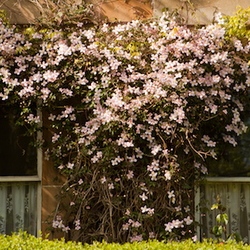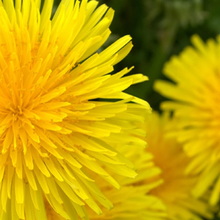Arctic Kiwi (Actinidia kolomikta) (pictured right)
Arctic Kiwi is a hardy vine most gardeners have never heard of. It is best known for its large pink and white variegated leaves and is hardy to zone 3. This beauty will grow in many different situations from full sun to partial shade, fertile soil to dry, clay soil. Arctic Kiwi grows best on a lattice, trellis or fence and can reach over 10 feet tall.
Arctic Kiwis can also set tasty fruit, similar to the common kiwi only small and purportedly sweeter. However, Arctic Kiwis are dioecious, meaning that a male and female plant have to planted in close proximity in order to set fruit/seed. The stunning variegation shows up best in male plants and mostly in more mature leaves on plants that are several years old.[1]
5-leaf Akebia (Akebia quinata)
Golden Hops (Humulus lupulus)
| Prized for its lime green foliage, Golden Hops Vine is a favorite for northern gardeners. Golden Hops Vine has sticky stems and maple-like leaves which grow and cover fences and structures quickly. Hardy to zone 4, it blooms inconspicuous white flowers in mid-summer followed by chartreuse whimsical, papery hops. Golden Hops requires full to partial sun and will grow best in moderately moist, fertile soil, though tolerates poorer soils. For more historical and colloquial information, visit this site on Golden Hops Vine. |
Climbing Hydrangea (Hydrangea anomala subsp. petiolaris)
|
Climbing Hydrangea does best when planted near and allowed to climb brick walls, tall trees or other sturdy structures because it attaches using aerial roots. It will do best in partial to full sun and is hardy to Zone 4.[3] |
Coral Honeysuckle (Lonicera sempervirens)
Poor Man's Ginseng (Codonopsis pilosula)
Grape (Vitis)
Cream Pea Vine (Lathyrus ochroleucus)
Wisteria
|
Wisterias are a classic choice if you are searching for a very hardy vine. There are all sorts of rumors swirling about Wisteria: they're invasive, they are impossible to make bloom, they are impossible to make grow, etc. Depending on your climate and the particular place you put a Wisteria, any or all of these rumors could be true. Whether you love them or hate them, Wisterias can be a beautiful addition to your perennial garden. Keep in mind that there are 3 different kinds of Wisteria, each with its own merits and visual qualities. Wisterias need a very strong support, whether it is an arbor, trellis, or wooden swing. They are vigorous growers and their arching stems can grow several feet each season. It will take a Wisteria many years to bloom if grown from seed, so starting out with a grafted or vegetatively propagated plant will give you a jump start. Wisterias prefer well-drained acid soil and once established, don't need much extra water in the summer months. No matter which Wisteria you choose, you'll surely be adding a beautiful and romantic spot in your garden. |
 |
 |
 |
|
Chinese |
Japanese |
American |
Clematis
|
A favorite among perennial vines, clematis offer a wide range of colors and growing habits. Most clematis are hardy to zone 3, making them a beautiful and resilient vine for difficult climates. Clematis can be intimidating because of the different pruning groups and sometimes picky growing conditions. However, they are actually much easier to keep than most people think. You just have to know a few certain tricks. Give them shaded roots and obey the rules of their individual pruning groups and you will have a flourishing, floriferous vine. Check out these articles for further information on pruning groups and cultivars. |
 |
|
Don't be discouraged by cold, ruthless winters. There are plenty of beautiful vines out there that you can grow in colder climates. We don't end up sacrificing attractiveness or interesting foliage on account of hardiness. Dig in! |
When you purchase through links on our site, we may earn commissions at no cost to you.


























